Die Tat is a deed or an act, and if it’s done by der Täter, it’s probably a criminal act. Der Ort is a city, locality, place, or site. Put them together, and you have der Tatort, the scene of the crime. You also have Tatort, surely the longest-running fictional crime show in the history of television because it started in 1970 and is still going strong. Maybe that’s because Tatort is uniquely German even in the way it’s filmed. The regional television stations each contribute Tatort episodes from their own parts of Germany, so there’s a pair of local fictional detectives solving crimes in Berlin, in Leipzig, in Hamburg, etc. Tatort is a show that celebrates Germany’s cultural differences and its unity at the same time. And Tatort detectives always find a way to put the clues together–from der Tatort, the crime scene.
The Last One Standing
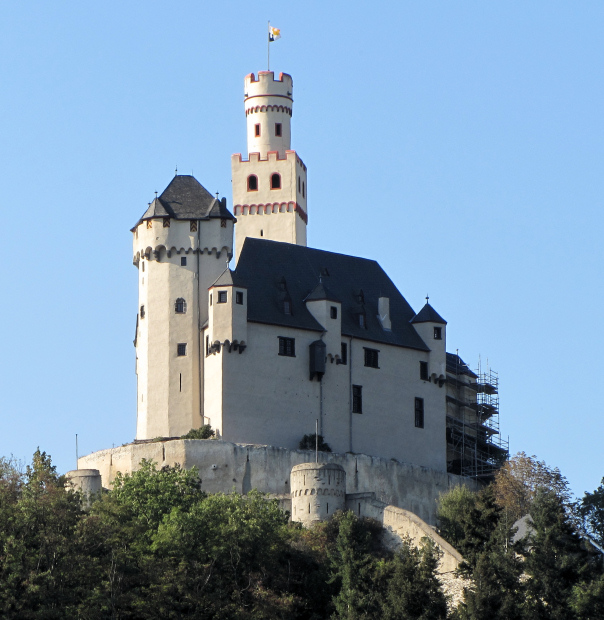
It wasn’t the prettiest medieval castle on the Rhine, or the biggest, or the richest, or the most famous. But the Marksburg is the only castle in the whole middle-Rhine region that didn’t get destroyed. All the others had to be built up from ruins at one point or another. That makes the Marksburg uniquely valuable to an author like me.
Joe wasn’t that thrilled with the Marksburg, but that was because he had to see it on a guided tour and didn’t have time to set up any of those gorgeous photographs he does so well. Me, I don’t set up gorgeous photographs. I just point and click. So I thoroughly enjoyed the tour.
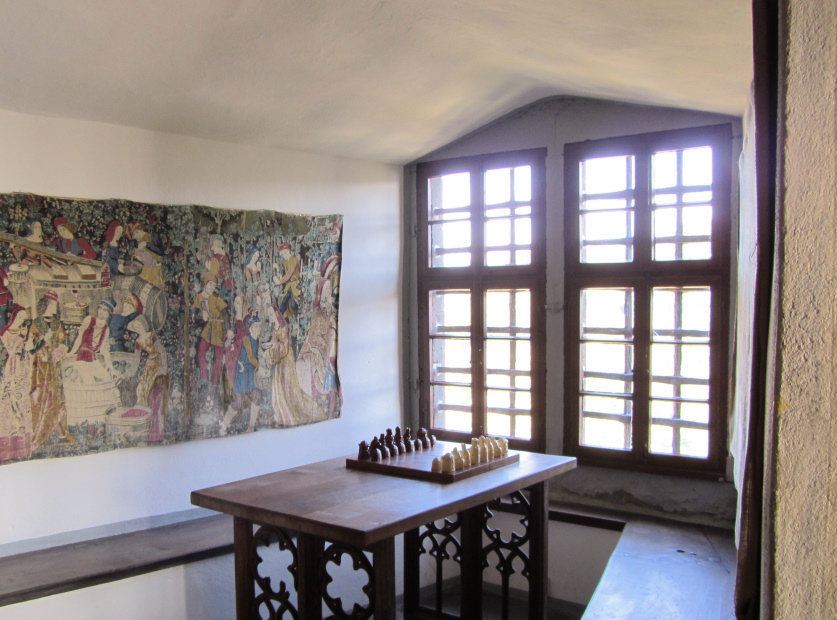
This isn’t a narrow room. It’s a window seat set into a wall that’s over eleven feet (3,5 m) thick! That’s a lot of wall, and it’s one of the reasons the Marksburg was never taken in battle.
I learned two truly wonderful things on the guided tour. The first is that the Marksburg belonged for several hundred years to the Grafen von Katzenelnbogen–the Counts of Cat’s-Elbow. No, they didn’t get the name because of cats or their constituent parts; in the ancient past, it was Cattimelibocus, which means something entirely different. But I think Cat’s-Elbow is a splendid name. I’ll have to work it into a book somewhere.
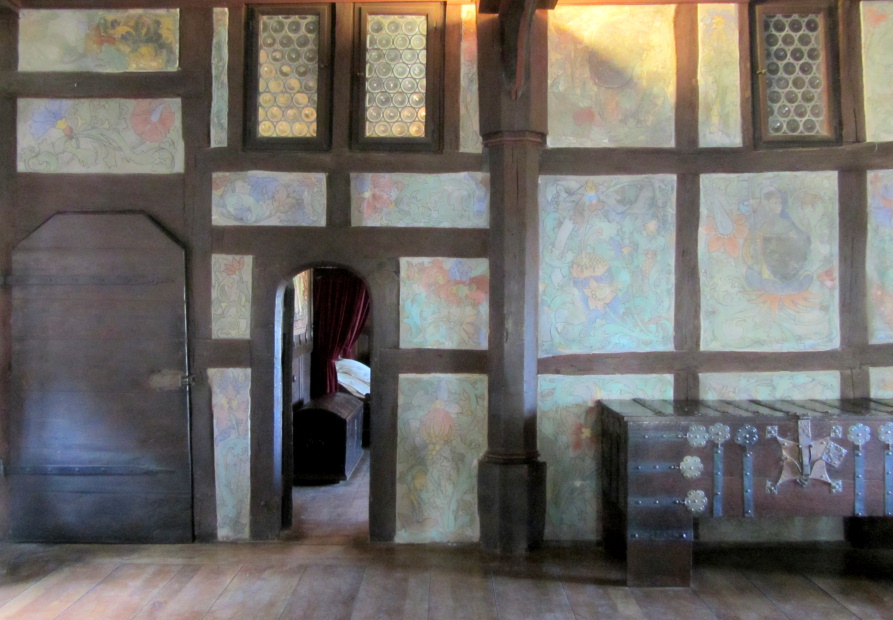
The second wonderful thing I learned is that when a king’s or high-ranking nobleman’s ship floated down the Rhine, a castle was required to fire its cannons in salute (without cannon balls, naturally). A salute is a pretty idea in principle, but there are over sixty castles on the middle Rhine, each one firing its own salute. To paraphrase Scott Adams, that has ‘long day’ written all over it.
Photographs taken in September, 2011, at the Marksburg, Germany. Text and photographs copyright 2011 by Clare B. Dunkle.
Today’s German word comes with a photo:
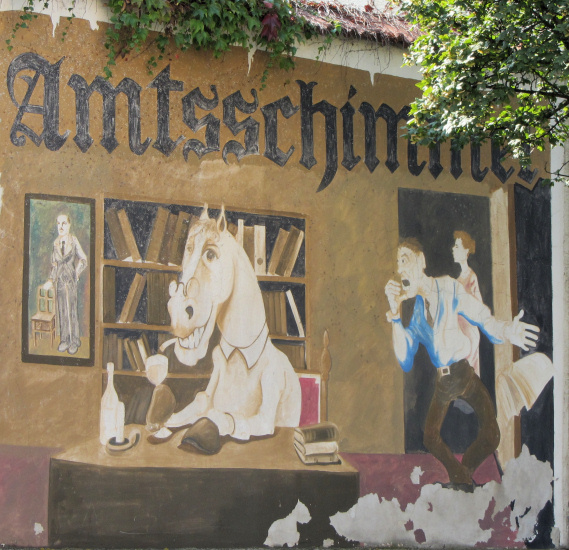
Der Schimmel is a white horse (also mold, but that’s another post). Das Amt is an administrative office. Put them together, and you get der Amtsschimmel, the dreaded beaurocratic mess we Americans call red tape. Why is red tape a white horse? No one knows anymore. But when someone does everything by the book, Germans say he likes to ride the Amtsschimmel–den Amtsschimmel reiten. And wherever things are wrapped up in a ridiculous amount of red tape, people say der Amtsschimmel wiehert–the Amtsschimmel neighs. Take, for example, the now revoked European Union Commission Regulation No 2257/94. It forbade the sale of bananas that have “abnormal curvature”! Der Amtsschimmel must have had a good long horse laugh over that.
Learning German with Lucky Luke
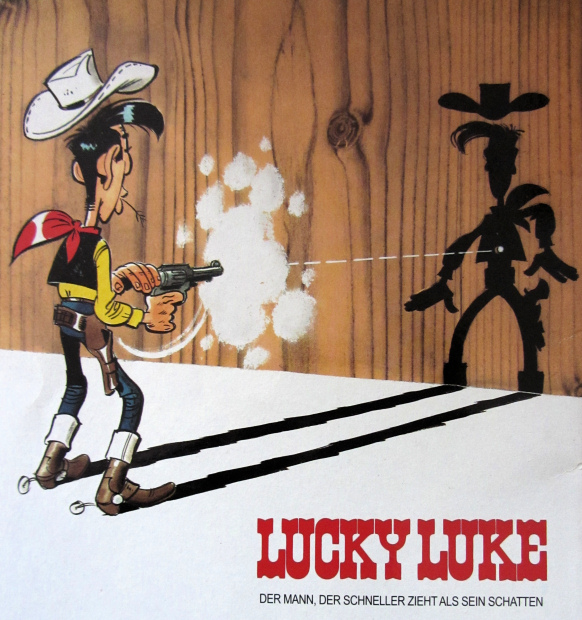
I don’t just sit around and watch television all day. Sometimes I read books. Comic books, that is–and my favorite is Lucky Luke, the man who shoots faster than his shadow.
Television is a great way to learn a foreign language, but it refuses to slow down long enough for me to look up all the words. So I spend time reading German too, and comic books are an excellent choice. All the sentences are spoken dialogue, so I won’t end up “sounding like a book.” I get lots of visual clues to help me understand what’s going on, and besides, I get to laugh.
Lucky Luke is the creation of the great Belgian cartoonist, Morris, and many of the issues were cowritten by the equally great Goscinny, who gave us the comic series, Astérix. This means it was originally written in French. But it’s wildly popular in Germany, so I can be sure to find one of the more than 75 issues in any newsstand or grocery store.
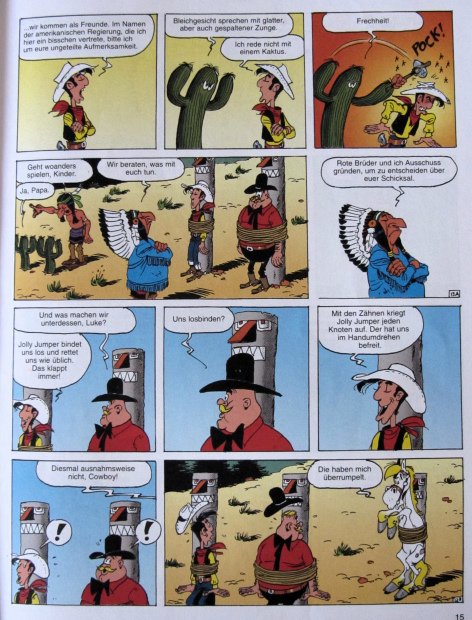
Maybe I like Lucky Luke so much because he’s an American like me. He wanders the Wild West on his brilliant and opinionated horse, Jolly Jumper, fighting for justice and locking up bad guys. He meets Calamity Jane, Sarah Bernhardt, and a young Horace Greeley. He helps out a traveling circus, rides for the Pony Express, and meets a cold-hearted bounty hunter who looks a whole lot like Lee Van Cleef. And of course, he tangles frequently with a band of desperate outlaws: the Dalton brothers, whose evil increases as their legs get shorter. Ma Dalton is pretty fierce too.
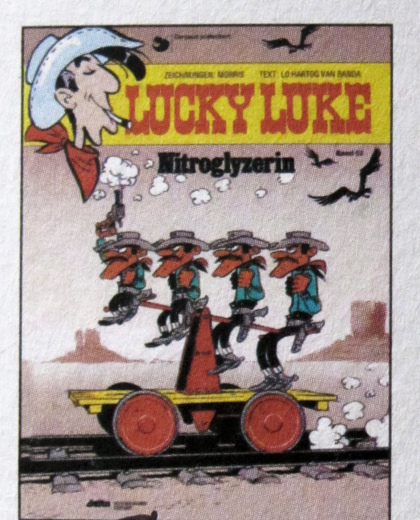
The other day, I had trouble locating Lucky Luke in the Globus supermarket. He wasn’t with the other comic books. That’s because Morris and Goscinny had a rotating rack all to themselves. Dozens of Lucky Lukes! I should have known.
Photos taken in September, 2011, by Clare B. Dunkle. Blog text copyright 2011 by Clare B. Dunkle. Images copyright Lucky Luke Comics, 2001. German translation copyright EGMONT EHAPA VERLAG GmbH, 2001.
In a cartoon skit by the famous German comedian Loriot, two grown men compelled by fate and a confusing hotel layout to share the same bathtub are having a genteel conversation (if marred by a certain amount of passive-aggressive behavior). But their polite chatter takes a nasty turn and tempers flare when one of the men–a college professor–wants his Ente in the bath. Die Ente is a duck–in this case, a rubber ducky. Eventually, the other man–a captain of industry–gives his permission with the supremely sarcastic statement, “Also lassen Sie die Ente in Gottes Namen herein”–“Let the duck in, in God’s name,” an expression that the porter of a castle might have used in medieval times. This so offends the professor that he snips in reply, “Nein, mit Ihnen teilt meine Ente das Wasser nicht”–“No, my duck’s not sharing the water with you!”
My Morning Jog
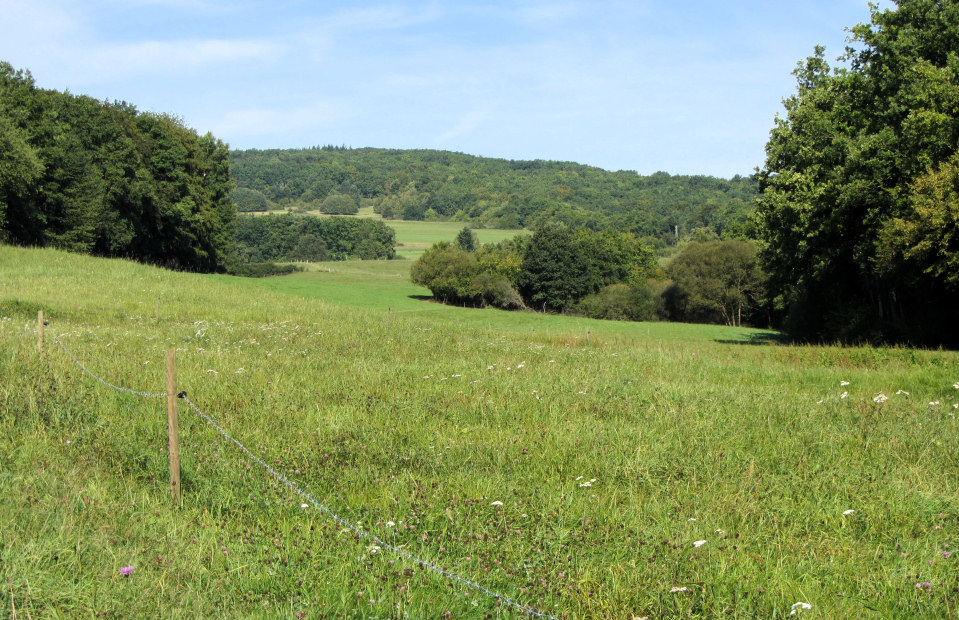
Jogging through scenery like this does more than tone the body. It heals the soul. I took this photograph today on my morning jog. Now, lest you think that I jog for miles, let me set you straight. The entire jog took only 45 minutes, and I walked a fair amount of that time. So this dreamy countryside isn’t miles away. It’s just around the corner.
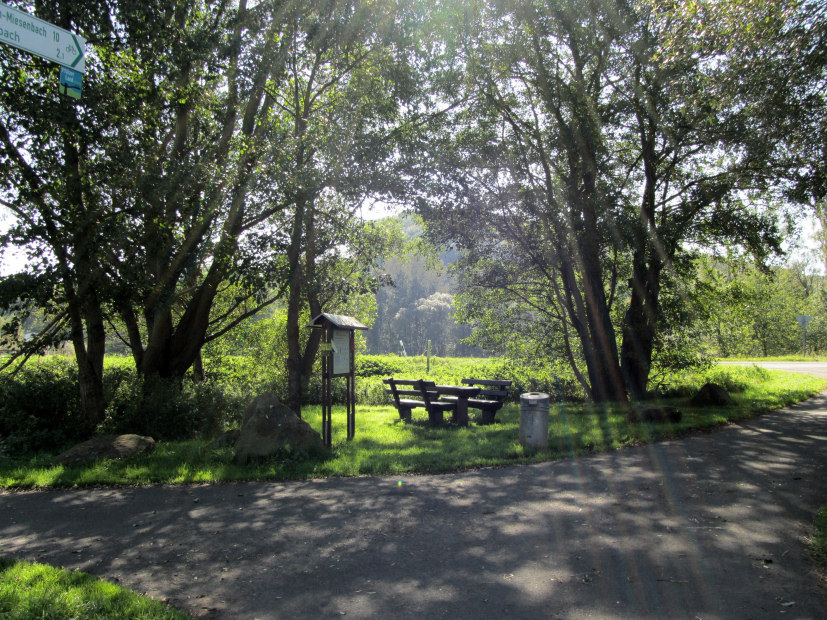
This part of Germany is covered by a latticework of small paved or unpaved roads that have been closed to all motorized traffic except for agricultural or forest vehicles. These roads are now walking, jogging, and biking trails (horses are often okay too). Picnic tables and benches appear at regular intervals along them, and signs pointing to the nearby towns keep the walker or bicyclist from getting lost. (You can see the tip of such a sign at the top left of this photo.)
Would I want my daughters to jog out here? Well, probably I would. For one thing, these trails are well used; I never go longer than a couple of minutes without seeing another jogger, a bike team, a woman with her dog, or a retired couple out for a stroll. Also, crime is rarer here than it is in the States. According to the best statistics I can find, the murder rate (per 100,000 inhabitants) for all of Germany is about half what it is for my home city of San Antonio, Texas. And the rate of reported rapes is only about a quarter of what it is back home. What’s more, these statistics include the crime-ridden cities in the north of Germany, such as Berlin, Bremen, and Hamburg. The rate of crime where I live in the Rhineland-Palatinate (Rheinland-Pfalz) is much lower than that.
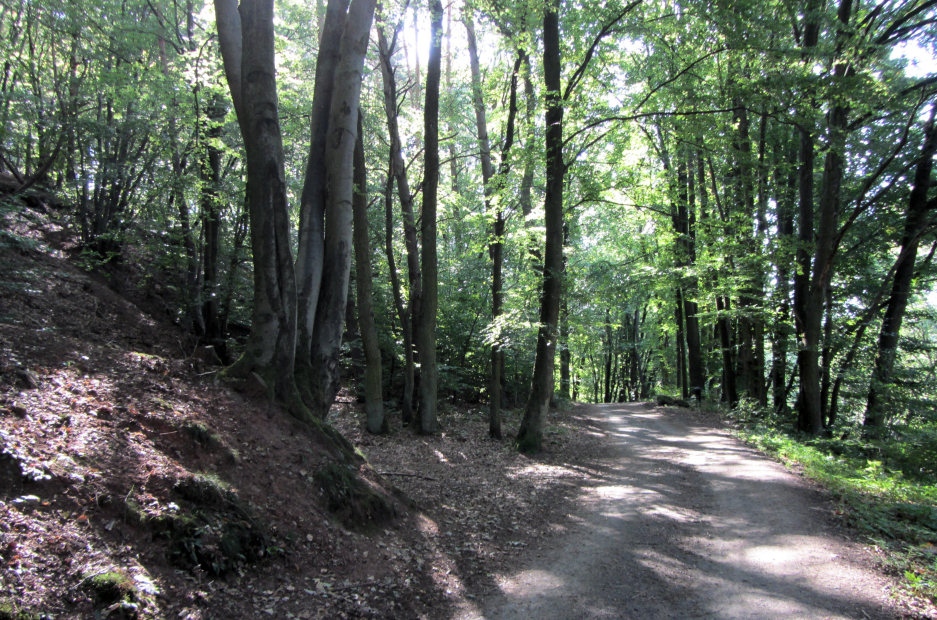
With beauty like this all around me, the crime would be to stay indoors!
Photos taken in September, 2011, near Rodenbach, Germany. Text and photos copyright Clare B. Dunkle. Crime statistics roughly estimated (with apologies) from Entorf, Horst & Hannes Spengler, Socio-economic and demographic factors of crime in Germany: Evidence from panel data of the German States. 1998. Also from City-data’s San Antonio entry.
English just has yes and no, but German has ja and nein … and doch. If ja means yes and carries the idea, “I agree,” then doch means “I know you don’t agree with me, but yes!” Doch is one of those wonderful words that normally only native speakers get right, but my daughters spent so long in German boarding school that they mastered the intricacies of the language without realizing it. I remember Valerie, home from school on a free weekend, telling me about a game they had played at a fair, where they dropped a ball through water in order to get it into a cup.
“That’s a typical midway game,” I told her. “You can’t win it.”
Without missing a beat, she said, “Doch, we got it three times.”
The Sport for Real Men
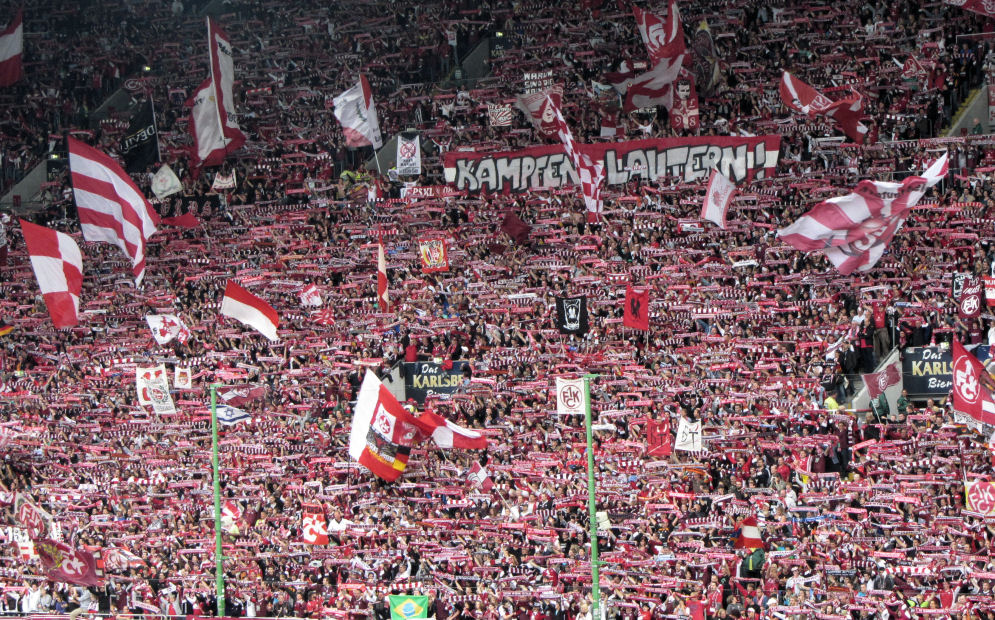
This is a crowd of over 10,000 people on their feet, holding out their long mufflers as they cheer on Fussball-Club Kaiserslautern, or 1FCK, during their match against Mainz this last Saturday. How do I know these people are on their feet? Because their part of the stadium doesn’t have seats. Real fans don’t sit down. Ever. Seats would only get in the way of their yelling, chanting, singing, banner-waving, and jumping up and down. (You haven’t lived till you’ve seen 10,000 people jump up and down. It is, as my son-in-law would say, hardcore.)
I was sitting down, though, in one of the 32,000 seats the stadium has in addition to its 16,000 non-seats. I’m not hardcore. But I did have a lot of fun. Rainer has season tickets, and he and Heidi took Joe and me. We loved it. If we lived here, we would buy season tickets immediately. Good coordination with the public transit authorities makes getting to the game especially easy; your ticket to the game acts as a free pass on area trains and buses, and park-and-ride buses run every five minutes.
Kaiserslautern won 3-1. I took this photo just a second before one of their goals.
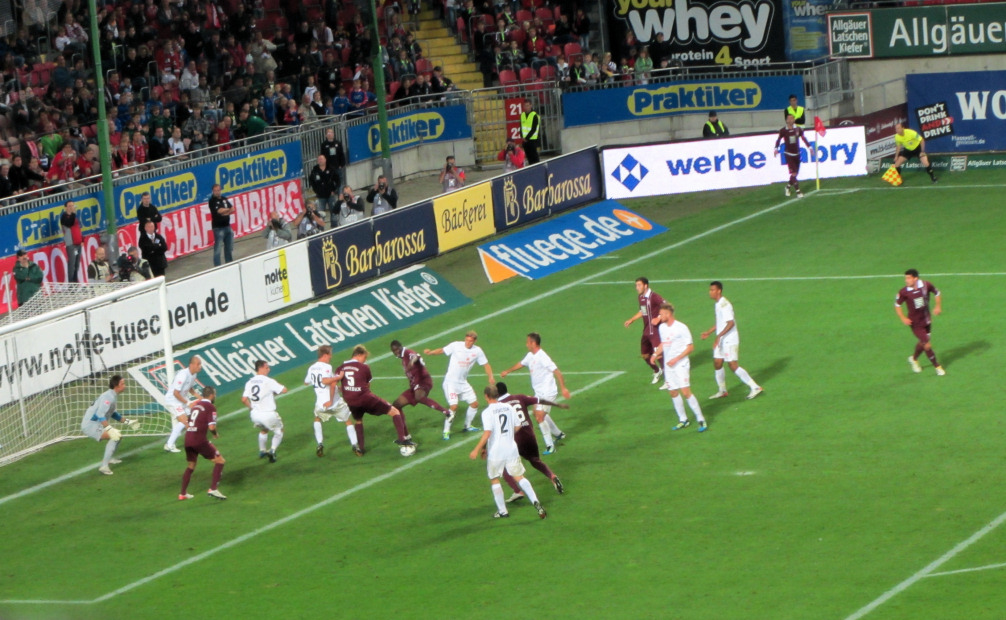
The thing that really impressed me about the game is the way we were left in peace to enjoy it. There was no Jumbotron, no annoying scrolling light display, no constant loudspeaker chatter. The video scoreboard kept strictly to the score, and the announcer came on only to announce goals or player substitutions. This left the fans on their feet at the end of the stadium free to organize their own singing and cheering. And we could all do what we were there to do: focus on the game.
With five minutes left to go, it was clear that Kaiserslautern would win. So all the Kaiserslautern fans pulled white hankies out of their pockets and waved them to the losing team while they sang, “Auf Wiedersehen, es war so schön”–“See you later, it’s been grand.”
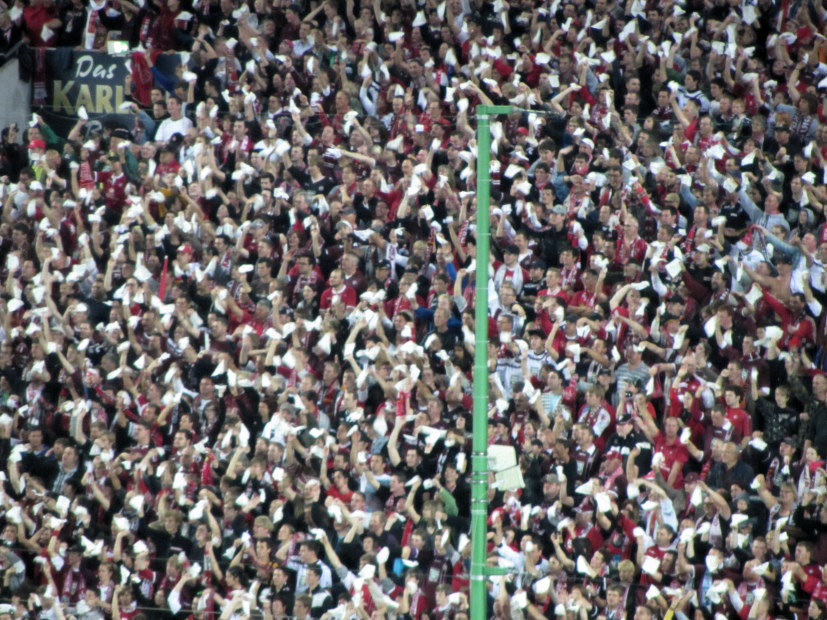
Photos taken in September, 2011, in the Fritz-Walter-Stadion, Kaiserslautern, Germany. Text and photos copyright 2011 by Clare B. Dunkle.
The other night, I was watching the European Jumping Championships on Eurosport. An excellent German rider was all set to win the gold medal when his horse took down a bar on the very last jump. That bar, said the announcer, was the difference between Gold und gar nichts. It’s easy to understand that nichts is nothing. But what about gar? This word comes from garen, to cook, and it means anything cooked all the way through or done completely. (Half-baked, in German, is halbgar.) So gar nichts is absolutely nothing, and it’s not changing now–nothing can be done to mend it. And that’s what the poor German rider won.
Strolling and Nibbling
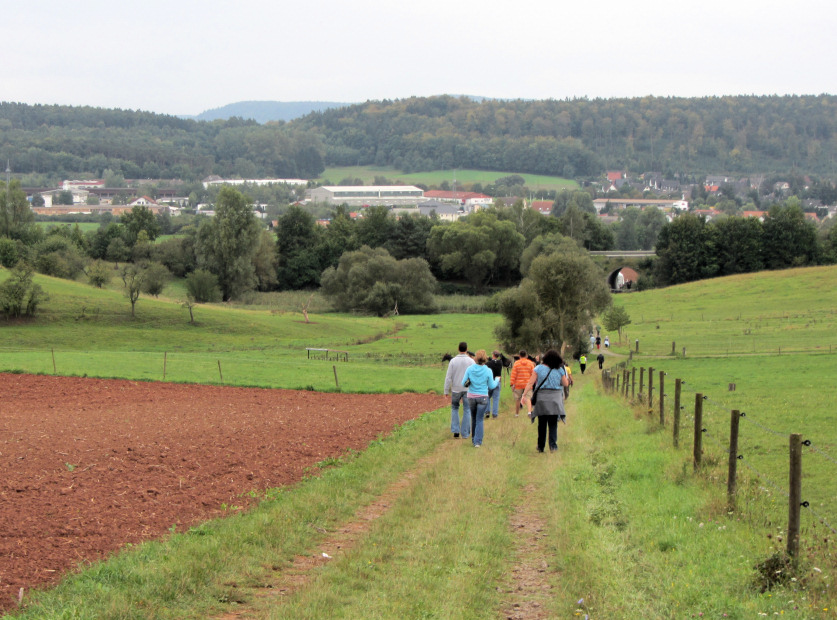
This Saturday and Sunday, Rodenbach and nearby Weilerbach teamed up to host their annual Kulinarische Wanderung–literally translated, a culinary stroll. This proved to be every bit as enjoyable as it sounds. The three-and-a-half-mile (six-kilometer) route passed nine different tents offering such delicacies as freshly smoked salmon and “rusty knights” (a kind of sweet French toast). And wine. Lots of wine! Participants could purchase a little glass on a rope to hang around their necks and sample wines along the route for a euro apiece.
Combining a stroll with a festival is natural to Germans, who turn out in great numbers every weekend all year round for organized walks of every description. Volunteers mark out a pretty walk and set up tents and Toi-Tois along the way, and everybody and his dachshund shows up to take in the fresh air and fun. We were walking with Rainer and Heidi on Saturday, and they must have met forty people they knew along the route.
Not everybody had to walk.
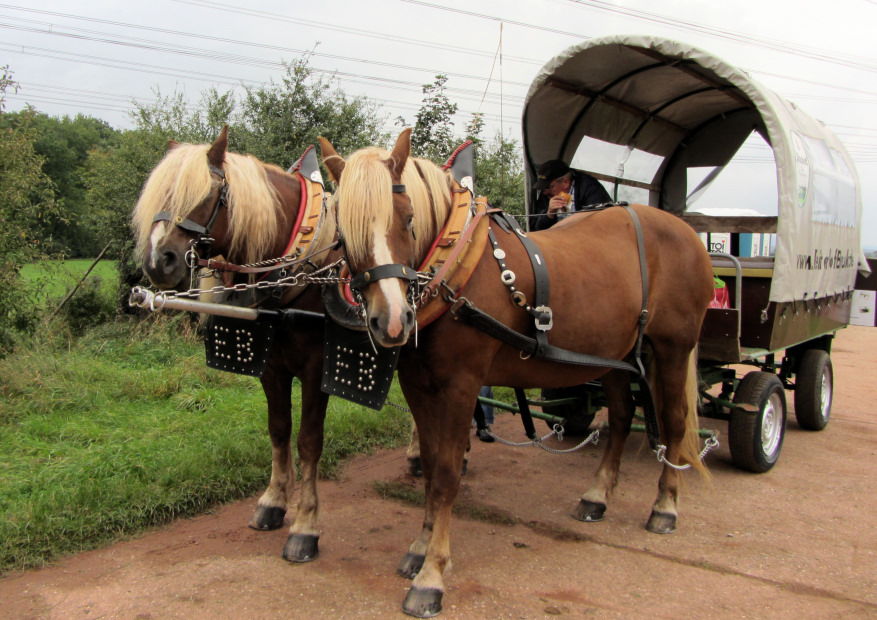
The scenery was peaceful, the food was great, and the wine was even better at the Kulinarische Wanderung Rodenbach. Thanks to the extensive network of paved paths dedicated exclusively to recreational sports over here, we didn’t have to worry about dodging cars along the way like we would have back home in America. Strolling from tent to tent, we sampled saumagen burgers (no, it’s not a real stomach!), flammkuchen, spice cake, merguez (a sausage made from lamb), and some local barbecue, which was quite a bit better than we expected it to be. We could have eaten twice as much and drunk about eight times as much, and then the Wanderung would have involved some real wandering. But we had tickets to the FCK football match. More on that tomorrow.
These two colorful characters from the Austrian Tyrol entertained visitors at the Engel Wellness Hotel tent.
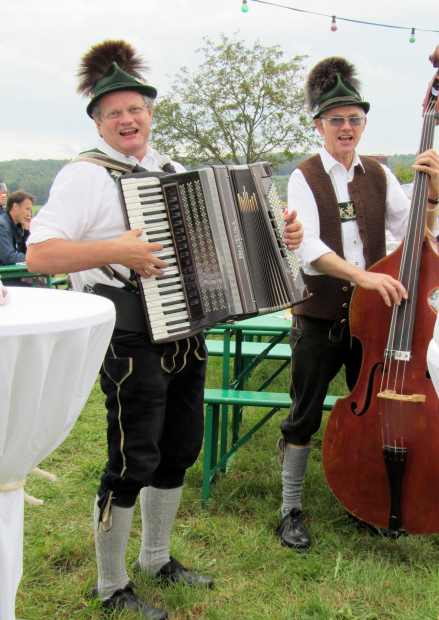
Photos taken in September, 2011, near Rodenbach, Germany. Text and photos copyright 2011 by Clare B. Dunkle.
